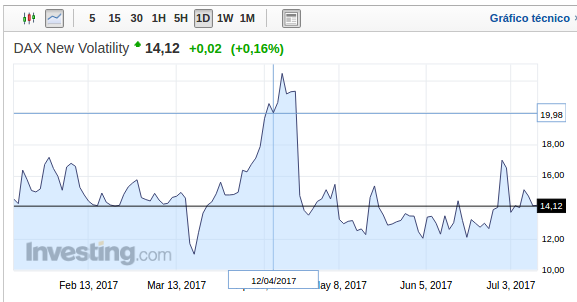In the unlikely case that you have followed this blog since its inception, you might have noticed that it contains different "learning notes" that I have compiled while learning different technologies and tools, all of the software related, which I wanted to share with anyone interested.
Apart from the software development, I have other hobbies, one of them being the stocks, derivatives and the markets in general. A while ago, I started learning about stock options trading and after some studying I began, at the start of 2017, performing some actual trades using the options over the DAX30 index (the index holding the 30 biggest traded German companies). They are called ODAX, by the way.
So today, I would like to introduce you the system I have followed for the better part of this year, which I would like to polish as I continue learning about stock options trading. Feedback is always welcome!
Trading system rules
Every system has some rules that one should follow as much as possible (I try to, but it has not always been the case, this is bad!). These rules dictate when to open (enter) and when to close (exit) each trade:
Opening conditions
- 60 to 80 DTE (days to expiration)
- Trade uses an Iron Condor (a Credit Call Spread + Credit Put spread)
- Sort leg deployed at 16 delta
- 400 points wing width (distance between the sold and bought options)
- IV (Implicit Volatility) > 15% (if possible)
- I use VDAX index provided by Investing.com
 |
| DAX volatility index, the higher it is, the higher the options premium. Source Investing.com |
I also use some technical analysis (resistances, support lines, RSI, etc.) but it is not my best field of knowledge.
- Close when 50% of the maximum profit is reached.
- Or 30 days to expiration are left
Adjustment conditions
- When one of the spreads (leg) hits a 30 delta (30% probability on ending up "in the money")
- Close the profitable leg
- Redeploy it again for more credit (if there are still 30 - 45 days at least before expiration)
400 points (the width) * 5€/point (the ODAX multiplier) - (premium from Call and Put spreads)
This usually amounts to around 1.600€, which is close to 1/10th of the whole account. Trading this small helps reducing the risk of wiping the account!
Trades executed this year (so far)
 |
| Screenshot from the trades spreadsheet (see link below) |
That was an excerpt of the trades done so far. I´m sure you will not doubt about their authenticity, as the results are rather mediocre (the DAX index has beaten me quite clearly: 7,2% vs 6.6% since the beginning of the year). Yes, this means buying an ETF and do nothing was better that doing this!
 |
| DAX went from 11,599 to 11,437 (+7,2%). Source Investing.com |
Current portfolio
This is my options portfolio at the time of this writing:
 |
| Currently my portfolio is composed of a September Iron Condor |
Plans for the future
I am an amateur learning, so I don't aim for beating anything (I will try not to lose the allocated money for this experiment!) but I would like to publish the evolution of my portfolio and gather the feedback of the community so I keep learning on this interesting subject.
Stay tuned!
No comments:
Post a Comment